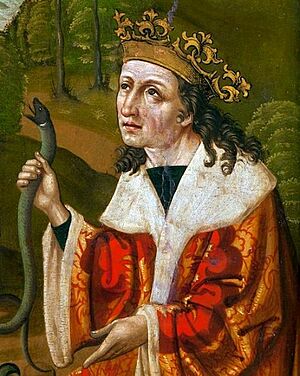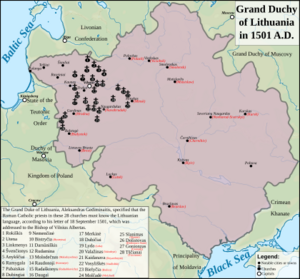Alexander Jagiellon facts for kids
Quick facts for kids Alexander Jagiellon |
|
|---|---|

As king of the Saracens, probably the most accurate portrait of Alexander, c. 1504
|
|
| Grand Duke of Lithuania | |
| Reign | 30 July 1492 – 19 August 1506 |
| Coronation | 30 July 1492 in Vilnius Cathedral |
| Predecessor | Casimir IV Jagiellon |
| Successor | Sigismund I the Old |
| King of Poland | |
| Reign | 12 December 1501 – 19 August 1506 |
| Coronation | 12 December 1501 in Wawel Cathedral |
| Predecessor | John I Albert |
| Successor | Sigismund I the Old |
| Born | 5 August 1461 Kraków, Poland |
| Died | 19 August 1506 (aged 45) Vilnius, Lithuania |
| Burial | Vilnius Cathedral, Vilnius, Lithuania (1506) |
| Spouse | Helena of Moscow |
| Dynasty | Jagiellon |
| Father | Casimir IV Jagiellon |
| Mother | Elisabeth of Hungary |
| Signature | |
Alexander Jagiellon (born August 5, 1461 – died August 19, 1506) was an important ruler from the Jagiellon dynasty. He became the Grand Duke of Lithuania in 1492. Later, in 1501, he also became the King of Poland. He ruled both until his death in 1506. Alexander was the fourth son of King Casimir IV Jagiellon. When his father passed away, the people of Lithuania chose Alexander to be their Grand Duke. When his brother, John I Albert, died, the Polish people chose Alexander to be their King.
Contents
Alexander Jagiellon: King and Grand Duke
Alexander was born in 1461. His father was King Casimir IV of Poland. His mother was Elisabeth, whose father was the King of Hungary. Alexander had several brothers. His oldest brother, Vladislaus, became King of Bohemia and Hungary. Another brother, Casimir, lived a very religious life and later became a saint.
When their father died in 1492, the Polish nobles chose Alexander's brother, John I Albert, to be the next King of Poland. However, the Lithuanians chose Alexander to be their new Grand Duke. Alexander spent a lot of time in Lithuania. He even had Lithuanian priests working in his royal chapel.
Challenges as Grand Duke
One of the biggest problems Alexander faced as Grand Duke was attacks on Lithuania. These attacks came from Grand Duke Ivan III of Russia and his allies, the Tatars from the Crimean Khanate. Ivan III believed he should rule the lands of Kievan Rus'. He wanted to take back areas that Lithuania had gained.
Alexander could not stop these attacks. So, he sent people to Moscow to make a peace deal. This deal was signed in 1494. Lithuania had to give up a lot of land to Ivan. To try and make the peace last, Alexander married Helena, who was Ivan III's daughter. They got married in Vilnius in 1495.
However, the peace did not last long. Ivan III started fighting again in 1500. Alexander tried to protect cities like Smolensk. His wife, Helena, even tried to help make another peace deal with her father after a big battle called Battle of Vedrosha in 1500. In 1503, a new peace deal was made. Lithuania had to give up about one-third of its land to Russia. This showed that Russia was growing stronger and had a powerful army.
Becoming King of Poland
On June 17, 1501, Alexander's older brother, John I Albert, died suddenly. This meant Alexander was next in line for the Polish throne. He was crowned King of Poland on December 12, 1501.
As king, Alexander often struggled with money. This made him depend on the Polish Senate and the nobles (called szlachta). They took away some of his power. For example, they took control of the mint, which made coins and was a big source of money for the king. They also tried to limit his royal powers.
In 1505, the Polish parliament, called the Sejm, passed an important law known as the Act of Nihil novi. This law meant that the king could not make new laws without the agreement of the nobles. This was a big step for Poland. It meant that the country was moving towards a "Noble's Democracy." In this system, the nobles had a lot of say in how the country was run.
Later Years and Legacy

During Alexander's time as king, Poland also faced problems with Moldavia, a region that was supposed to be under Poland's control. Things only got better when the powerful ruler of Moldavia, Stephen, died.
Alexander also received help from Pope Julius II. The Pope sent money and support to Poland. This helped Alexander deal with the Teutonic Order, a powerful group of knights who were causing trouble.
Alexander felt more at home in Lithuania than in Poland. He often favored his Lithuanian friends and helpers. One important Lithuanian was Michael Glinski. Glinski proved his loyalty by winning a great victory against the Tatars at Kleck on August 5, 1506. The news of this victory reached Alexander just before he died in Vilnius.
Some historians believe that Alexander was the last ruler from the Gediminid dynasty who understood the Lithuanian language. However, there are not many old writings to confirm this.
In 1931, Alexander's forgotten tomb was found during work on Vilnius Cathedral. His sarcophagus (a stone coffin) is now on display there.
Gallery
-
King Alexander in Polish Senate, 1506.
-
Alexander and his kanclerz Jan Łaski.
-
In 1504 he ordered to rebuild the Wawel in a Renaissance style.
-
Lithuanian coin with the coat of arms of Lithuania and Poland
See also
- History of Poland during the Jagiellonian dynasty
- Rachela Fiszel
- Sejm walny
- St. Anne's Church, Vilnius










